From condition assessment to service life extension: NDT-driven maintenance for coastal bridge durability
Case Study
Dr. Sauvik Banerjee, Co-founder & Director, Nirixense Technologies (August 2025)
Coastal infrastructure is constantly challenged by the harsh marine environment. Over time, chloride exposure can damage both concrete and steel, sometimes faster than expected. Even advanced protection methods (such as fusion-bonded epoxy-coated reinforcement bars) may not completely stop deterioration. A recent study of a 613-metre coastal flyover bridge highlights how early corrosion can impact structural strength. It also shows how NDT and well-planned retrofitting can help extend the lifespan of critical structures.
The challenge of early corrosion despite protective coatings:
Built in 2002, the flyover consists of 14 spans made from precast prestressed concrete girders and cast-in-situ deck slabs, supported by reinforced concrete piers with pot bearings. Although fusion-bonded epoxy-coated rebars were used to protect against corrosion, signs of distress appeared within just 15 years. Cracks developed in the girders, diaphragms, and slabs, and corrosion was observed in the bearings. This case shows that while protective coatings are helpful, they may not be enough on their own to withstand the harsh conditions of a coastal environment.
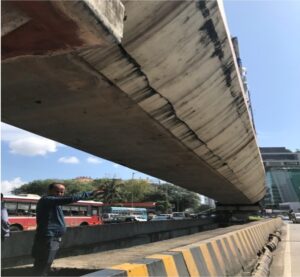
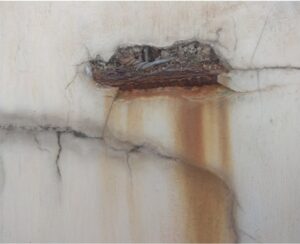
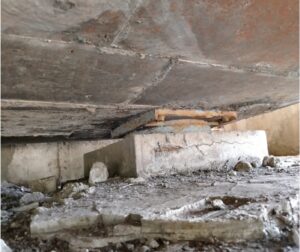
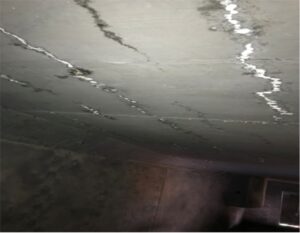
How NDT uncovered hidden risks:
To accurately evaluate the bridge’s condition, a comprehensive diagnostic approach using multiple non-destructive testing (NDT) methods was implemented:
- Rebar locator and covermeter: Used to map rebar positions and measure concrete cover thickness, helping to identify areas with inadequate cover and higher risk of chloride ingress.
- Concrete quality and strength tests: Ultrasonic pulse velocity and rebound hammer tests detected porous and weakened concrete, especially in the box girders and slabs.
- Corrosion activity measurement: Half-cell potential and electrical resistivity tests showed 50% likelihood of active corrosion, with corrosion rates exceeding 10 micrometres per year.
- Chemical analysis: Tests for chloride penetration and carbonation depth confirmed severe environmental attack that had reduced the concrete’s protective ability.
These findings, combined with numerical degradation modeling, provided a detailed picture of the structure’s health and its vulnerabilities.
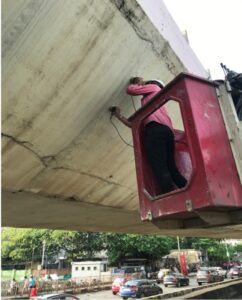
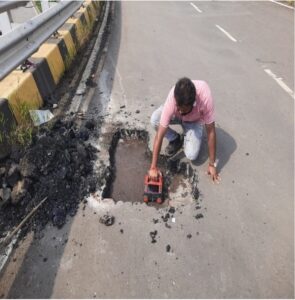
A thoughtful retrofitting strategy for extended service life:
Drawing from the insights gained, a carefully designed retrofitting strategy was proposed. This involved repairing or replacing damaged concrete sections with materials more resistant to harsh marine conditions. Corrosion inhibitors and sacrificial anode were recommended for corrosion mitigation. The plan used fiber reinforced polymers to strengthen key structural elements. Improving drainage and applying protective coatings designed for coastal exposure complete the approach. This plan, combining immediate repairs with long-term protective measures, improves durability. The plan is also useful as a model to be followed for other coastal structures.
Closing insights: NDT as the cornerstone of coastal durability
This case delivers a clear lesson: for harsh coastal environments, protective measures such as fusion-bonded epoxy coatings are not the only solution. True durability depends on understanding the specific exposure conditions and using NDT to detect hidden vulnerabilities. Data should be used to come up with a timely repair and rehabilitation plan.
Effective infrastructure management cannot stop at design and protective coatings alone. The early corrosion observed in this flyover serves as a warning. NDT offers the foresight needed to intervene before failures occur, enabling strategies that extend service life and improve reliability.
© 2025 Nirixense Technologies Pvt. Ltd. All rights reserved. email: connect@nirixense.com
About the Author: Dr. Sauvik Banerjee is Co-founder & Director at Nirixense Technologies, and Professor at Department of Civil Engineering, IIT Bombay. His experience includes structural health monitoring, using wave propagation and vibration-based approaches, quantitative nondestructive evaluation of structures, nondestructive testing, modelling of advanced composite structures, structural retrofitting and impact response of structures. He obtained Ph.D. degree from UCLA (Mechanical Engineering, 2003), M.Tech. from IIT Bombay (Civil Engineering, 2001).
Note: This article presents the author’s personal views and insights drawn from publicly shareable aspects of research and consultancy projects conducted as a faculty member at IIT Bombay. The content is intended solely for thought leadership and knowledge sharing. The views expressed do not necessarily represent those of IIT Bombay.






